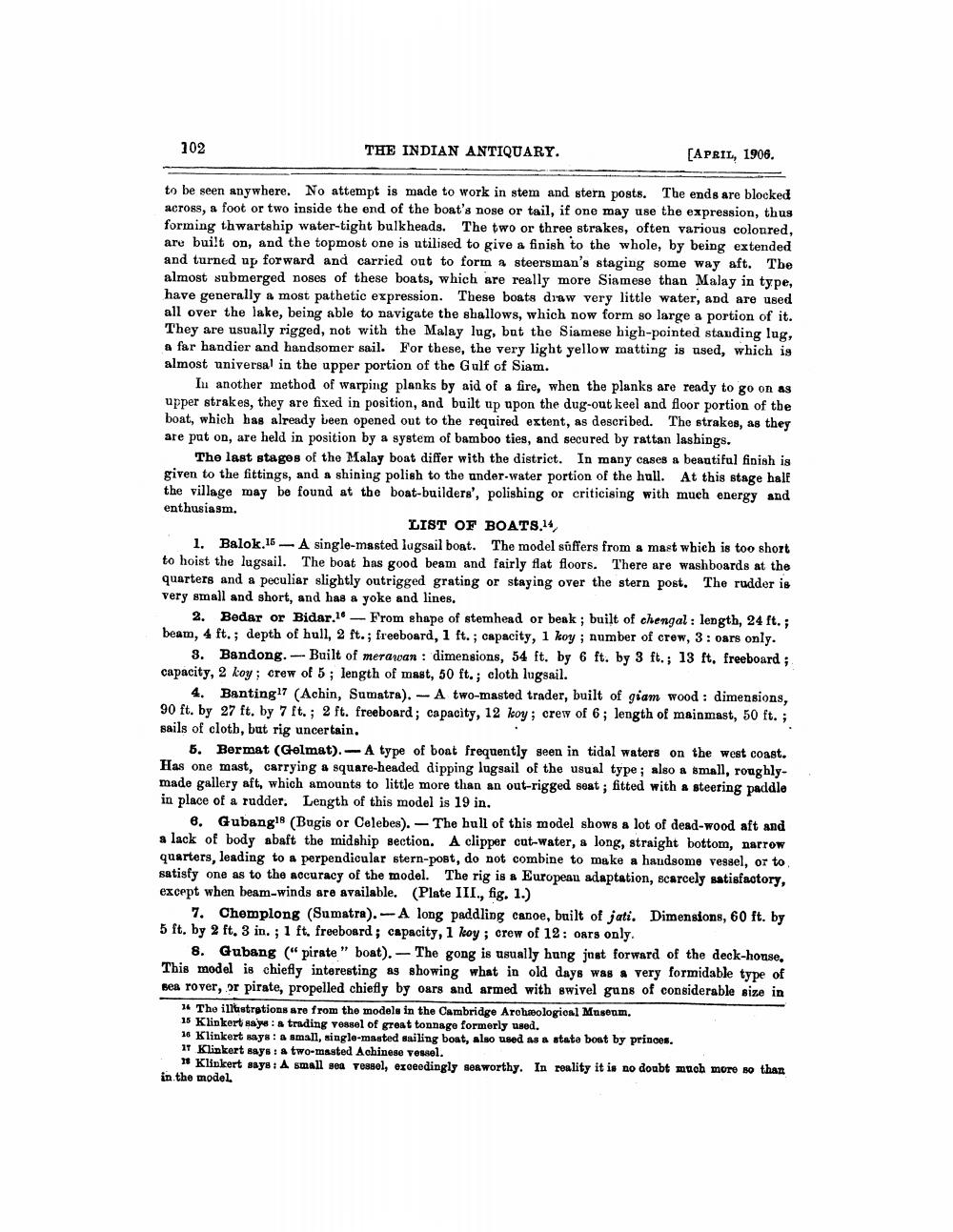________________
102
THE INDIAN ANTIQUARY.
[APRIL, 1906.
to be seen anywhere. No attempt is made to work in stem and stern posts. The ends are blocked across, a foot or two inside the end of the boat's nose or tail, if one may use the expression, thus forming thwartship water-tight bulkheads. The two or three strakes, often various coloured, are built on, and the topmost one is utilised to give a finish to the whole, by being extended and turned up forward and carried out to form a steersman's staging some way aft. The almost submerged noses of these boats, which are really more Siamese than Malay in type, have generally a most pathetic expression. These boats draw very little water, and are used all over the lake, being able to navigate the shallows, which now form so large a portion of it. They are usually rigged, not with the Malay lug, but the Siamese high-pointed standing lug, a far handier and handsomer sail. For these, the very light yellow matting is used, which is almost universal in the upper portion of the Gulf of Siam.
In another method of warping planks by aid of a fire, when the planks are ready to go on as upper strakes, they are fixed in position, and built up upon the dug-out keel and floor portion of the boat, which has already been opened out to the required extent, as described. The strakes, as they are put on, are held in position by a system of bamboo ties, and secured by rattan lashings.
The last stages of the Malay boat differ with the district. In many cases a beautiful finish is given to the fittings, and a shining polish to the under-water portion of the hull. At this stage half the village may be found at the boat-builders', polishing or criticising with much energy and enthusiasm.
LIST OF
BOATS.14,
1. Balok.15 A single-masted lugsail boat. The model suffers from a mast which is too short to hoist the lugsail. The boat has good beam and fairly flat floors. There are washboards at the quarters and a peculiar slightly outrigged grating or staying over the stern post. The rudder is very small and short, and has a yoke and lines.
2. Bedar or Bidar.1- From shape of stemhead or beak; built of chengal: length, 24 ft.; beam, 4 ft.; depth of hull, 2 ft.; freeboard, 1 ft.; capacity, 1 koy; number of crew, 3: oars only.
3. Bandong. Built of merawan: dimensions, 54 ft. by 6 ft. by 3 ft.; 13 ft. freeboard; capacity, 2 koy; crew of 5; length of mast, 50 ft.; cloth lugsail.
4. Banting17 (Achin, Sumatra). A two-masted trader, built of giam wood: dimensions, 90 ft. by 27 ft. by 7 ft.; 2 ft. freeboard; capacity, 12 koy; crew of 6; length of mainmast, 50 ft.; sails of cloth, but rig uncertain.
5. Bermat (Gelmat). A type of boat frequently seen in tidal waters on the west coast. Has one mast, carrying a square-headed dipping lugsail of the usual type; also a small, roughlymade gallery aft, which amounts to little more than an out-rigged seat; fitted with a steering paddle in place of a rudder. Length of this model is 19 in.
6. Gubang (Bugis or Celebes). The hull of this model shows a lot of dead-wood aft and a lack of body abaft the midship section. A clipper cut-water, a long, straight bottom, narrow quarters, leading to a perpendicular stern-post, do not combine to make a handsome vessel, or to satisfy one as to the accuracy of the model. The rig is a European adaptation, scarcely satisfactory, except when beam-winds are available. (Plate III., fig. 1.)
7. Chemplong (Sumatra).-A long paddling canoe, built of jati. Dimensions, 60 ft. by 5 ft. by 2 ft. 3 in.; 1 ft. freeboard; capacity, 1 koy; crew of 12: oars only.
8. Gubang (" pirate" boat). The gong is usually hung just forward of the deck-house. This model is chiefly interesting as showing what in old days was a very formidable type of sea rover, or pirate, propelled chiefly by oars and armed with swivel guns of considerable size in
-
14 The illustrations are from the models in the Cambridge Archeological Museum.
15 Klinkert says: a trading vessel of great tonnage formerly used.
16 Klinkert says: a small, single-masted sailing boat, also used as a state boat by princes.
17 Klinkert says: a two-masted Achinese vessel.
Klinkert says: A small sea vessel, exceedingly seaworthy. In reality it is no doubt much more so than in the model.




